
Gibbons are apes in the family Hylobatidae. The family historically contained one genus, but now is split into four extant genera and 20 species. Gibbons live in subtropical and tropical rainforests from eastern Bangladesh to Northeast India to southern China and Indonesia.
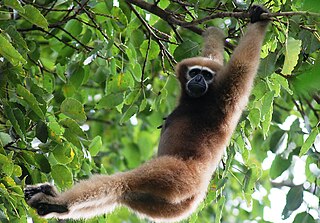
The hoolock gibbons are three primate species of genus Hoolock in the gibbon family, Hylobatidae, native to eastern Bangladesh, Northeast India, Myanmar, and Southwest China.

The genus Hylobates is one of the four genera of gibbons. Its name means "forest walker", from the Greek hūlē and bates.
Bunopithecus is an extinct genus of primate represented by one species, Bunopithecus sericus, a gibbon or gibbon-like ape. Its remains were first discovered in Sichuan, China, in strata from the Middle Pleistocene.

The brown spider monkey or variegated spider monkey is a critically endangered species of spider monkey, a type of New World monkey, from forests in northern Colombia and northwestern Venezuela.

The greater bamboo lemur, also known as the broad-nosed bamboo lemur and the broad-nosed gentle lemur, is a species of lemur endemic to the island of Madagascar.

The eastern lesser bamboo lemur, also known as the gray bamboo lemur, the gray gentle lemur, and the Mahajanga lemur is a small lemur endemic to Madagascar, with three known subspecies. As its name suggests, the eastern lesser bamboo lemur feeds mainly on bamboo. The lemurs of the genus Hapalemur have more manual dexterity and hand–eye coordination than most lemurs. They are vertical climbers and jump from stalk to stalk in thick bamboo forests.
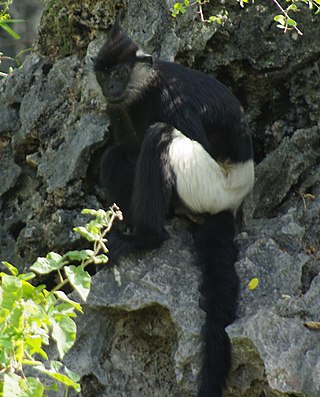
Delacour's langur or Delacour's lutung is a critically endangered species of Old World monkey endemic to northern Vietnam. It is named for French-American ornithologist Jean Théodore Delacour.

The Rondo dwarf galago or Rondo bushbaby is a species of primate in the family Galagidae. The dwarf galagos are the smallest members of the genus Galagoides. It weighs less than 100 grams, making it the smallest known galago. It is endemic to Tanzania where its natural habitat is subtropical or tropical dry forests. It lives in an area reported in 2012 to be less than 100 square kilometers and is threatened by habitat loss due to logging. While it was discovered in the 1950s, the Rondo dwarf galago was deemed data deficient until 1996. In 1996, the Rondo dwarf galago was fully described as a species. It is now listed as one of "The World's 25 Most Endangered Primates."
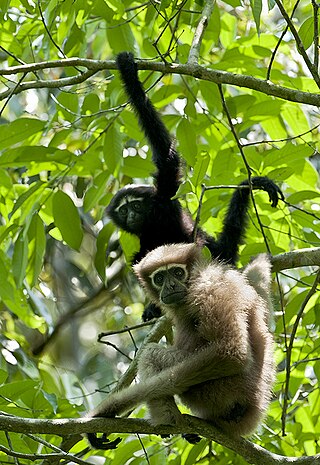
The Hollongapar Gibbon Sanctuary, formerly known as the Gibbon Wildlife Sanctuary or Hollongapar Reserved Forest, is an isolated protected area of evergreen forest located in Assam, India. The sanctuary was officially constituted and renamed in 1997. Set aside initially in 1881, its forests used to extend to the foothills of the Patkai mountain range.

The eastern hoolock gibbon is a primate from the gibbon family, Hylobatidae. It is one of three species of hoolock gibbon. This species is found in east of the Chindwin River, such as the Mahamyaing Wildlife Sanctuary, and in south west Yunnan of China. Recent study published in April, 2021, in International Journal of Primatology confirmed that this species is not found in India as it was thought to be.

The gray-headed lemur, or gray-headed brown lemur, is a medium-sized primate, a cathemeral species of lemur in the family Lemuridae. Until a taxonomic revision in 2008, it was known as the white-collared brown lemur or white-collared lemur. It lives in south-eastern Madagascar. In 2005, satellite imagery estimates showed approximately 700 km2 (270 sq mi) of total remaining habitat within its geographic range. It is highly threatened by hunting and habitat loss, and was considered to be among the 25 most endangered primates in 2006–2008. It is currently listed as Critically Endangered by the International Union for Conservation of Nature (IUCN) due to a highly restricted range, and has been named one of "The World's 25 Most Endangered Primates."

The Siau Island tarsier is a species of tarsier from the tiny volcanic island of Siau in Indonesia. The T. tumpara species is one of 14 species and 7 subspecies in the tarsier family called "Tarsiidae". They belong to the Haplorrhini suborder, known as the "dry-nosed" primates. The tarsier's eyes are so big that they do not move in its socket and they are almost as big as its brain. The name tumpara, which means tarsier in the local language of Sulawesi, was an attempt to encourage the community in preserving this biological heritage.

Lawachara National Park is a major national park and nature reserve in Bangladesh. The park is located at Kamalganj Upazila, Moulvibazar District in the northeastern region of the country. It is located within the 2,740 ha (27.4 km2) West Bhanugach Reserved Forest.

The World's 25 Most Endangered Primates is a list of highly endangered primate species selected and published by the International Union for Conservation of Nature (IUCN) Species Survival Commission (SSC) Primate Specialist Group (PSG), the International Primatological Society (IPS), Global Wildlife Conservation (GWC), and Bristol Zoological Society (BZS). The IUCN/SSC PSG worked with Conservation International (CI) to start the list in 2000, but in 2002, during the 19th Congress of the International Primatological Society, primatologists reviewed and debated the list, resulting in the 2002–2004 revision and the endorsement of the IPS. The publication was a joint project between the three conservation organizations until the 2012–2014 list when BZS was added as a publisher. The 2018–2020 list was the first time Conservation International was not among the publishers, replaced instead by GWC. The list has been revised every two years following the biannual Congress of the IPS. Starting with the 2004–2006 report, the title changed to "Primates in Peril: The World's 25 Most Endangered Primates". That same year, the list began to provide information about each species, including their conservation status and the threats they face in the wild. The species text is written in collaboration with experts from the field, with 60 people contributing to the 2006–2008 report and 85 people contributing to the 2008–2010 report. The 2004–2006 and 2006–2008 reports were published in the IUCN/SSC PSG journal Primate Conservation,, since then they have been published as independent publications.
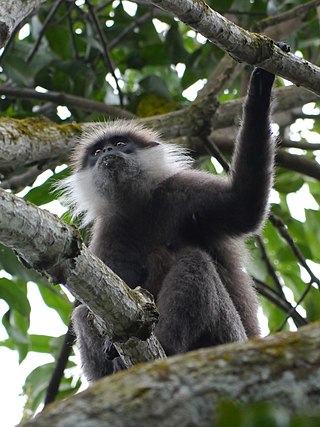
The western purple-faced langur, also known as the north lowland wetzone purple-faced langur, is a subspecies of purple-faced langur endemic to Sri Lanka. It lives in the wet zone in western Sri Lanka around the former capital city of Colombo. This subspecies are known to live in tropical rainforest, specifically in an area of Sri Lanka, where it is noted to rain two times more compared to the neighboring region. The subspecies is generally gray-brown with lighter whiskers, a gray rump patch, and dark forearms and legs. These monkeys also have dark brown or black, hairless faces. Their hands and feet are also hairless. When infants, their fur is medium brown to light gray, however it changes to their darker adult colors at between 12 and 16 weeks old. Typical length is between 48 and 67 centimetres excluding tail, with a 59 to 85 centimetres tail. On average, males weigh 8.5 kilograms (19 lb) and females weigh 7.8 kilograms (17 lb). Their average life span is about 26 years if the monkey was held in captivity. Due to their leafy diet, the western purple-faced langur back teeth, include high crowns and pointed cusps to make eating through greenery simpler. They also developed a digestive system that would allow them to break down cellulose in the leaves they eat. Although, leaves are their primary source of food, they also eat fruits and flowers. Female langurs hold a pregnancy for 195–210 days, and after the birth the offsprings are taken closely cared for by the mother until they are about 12–20 weeks old.

The Niger Delta red colobus is a critically endangered species of colobus monkey endemic to the western part of the Niger Delta. It is threatened by hunting and habitat loss.
The International Primatological Society (IPS) is a scientific, educational, and charitable organization focused on non-human primates. It encourages scientific research in all areas of study, facilitates international cooperation among researchers, and promotes primate conservation.
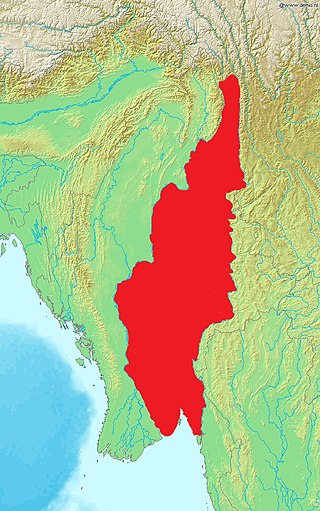
The Skywalker hoolock gibbon or Gaoligong hoolock gibbon is an arboreal primate in the gibbon family, Hylobatidae. It is one of three species of hoolock gibbon and was first described in January 2017 in the American Journal of Primatology. The Skywalker hoolock gibbon is one of two species of Eastern hoolocks: H. tianxing and H. leuconedys. Researchers estimate H. tianxing diverged from H. leuconedys roughly 490,000 years ago. The Eastern hoolock is vulnerable on the IUCN Red List, with a population of 310,000–370,000 individuals. Of this population, H. tianxing makes up less than 150 individuals, making the Skywalker hoolock gibbon an endangered species.



















